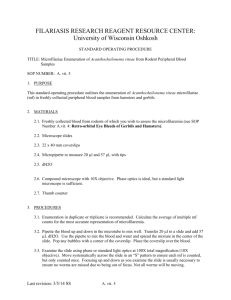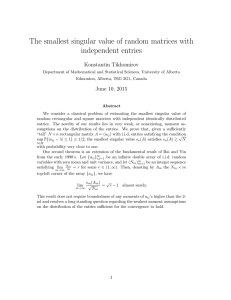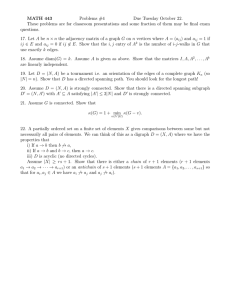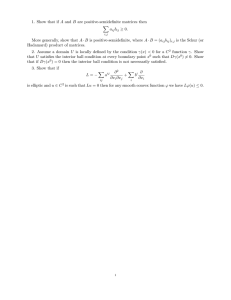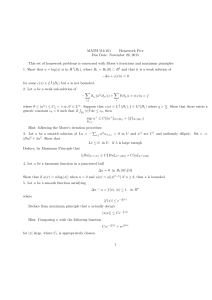18.S096: Homework Problem Set 5 Afonso S. Bandeira
advertisement
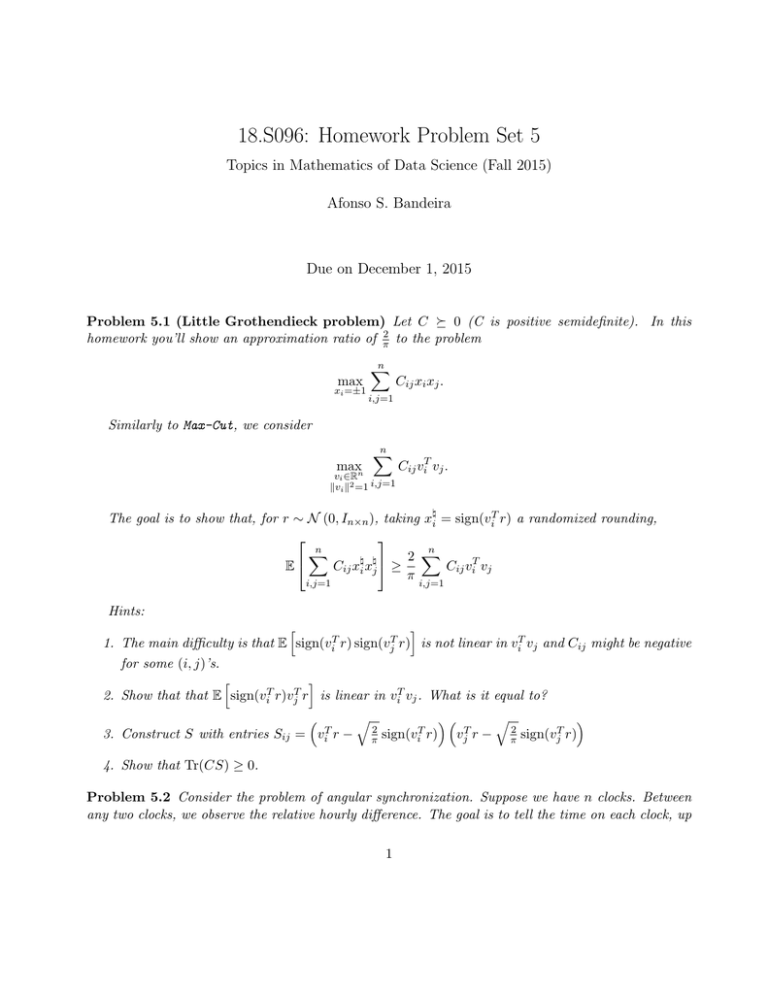
18.S096: Homework Problem Set 5
Topics in Mathematics of Data Science (Fall 2015)
Afonso S. Bandeira
Due on December 1, 2015
Problem 5.1 (Little Grothendieck problem) Let C 0 (C is positive semidefinite). In this
homework you’ll show an approximation ratio of π2 to the problem
n
X
max
xi =±1
Cij xi xj .
i,j =1
Similarly to Max-Cut, we consider
maxn
n
X
vi ∈R
kvi k2 =1 i,j =1
Cij viT vj .
The goal is to show that, for r ∼ N (0, In×n ), taking x\i = sign(viT r) a randomized rounding,
n
n
X
2 X
E
Cij x\i xj\ ≥
Cij viT vj
π
i,j=1
i,j =1
Hints:
h
i
1. The main difficulty is that E sign(viT r) sign(vjT r) is not linear in viT vj and Cij might be negative
for some (i, j)’s.
h
i
2. Show that that E sign(viT r)vjT r is linear in viT vj . What is it equal to?
3. Construct S with entries Sij =
viT r
−
q
2
π
sign(viT r)
q
T
vj r − π2 sign(vjT r)
4. Show that Tr(CS) ≥ 0.
Problem 5.2 Consider the problem of angular synchronization. Suppose we have n clocks. Between
any two clocks, we observe the relative hourly difference. The goal is to tell the time on each clock, up
1
to a global time shift. Let z = [eiθ1 , . . . , eiθn ]T ∈ Cn represents the ground truth time vector we try to
recover (θk ∈ [0, 2π], k = 1, . . . , n are effectively the time on the clocks). Then the true pairwise time
difference between clock k and l can be represented by
zk zl∗ = ei(θk −θl )
.
Consider Akl the observed time difference between clock k and l. Akl equals zk zl∗ with probability
p and Akl = eiφ with probability 1 − p. φ is a random uniform variable on the interval [0, 2π].
1. Since we know that when p is small Akl ≈ zk zl∗ , a way to solve the synchronization problem is
by solving
n
n X
X
|uk u∗l − Akl |2 , s.t. |uk | = 1, k = 1, . . . , n
min
u
k=1 l=1
Relax this to a problem of computing the eigenvector associated with the maximum eigenvalue of
a matrix.
2. The goal is to understand when the eigenvector method returns meaningful solution. Without
loss of generality we can assume zi = 1 for all i.
• In that case what is EA?
• Are the entries of A − EA independent (and identically distributed)?
• If the entries of A were Gaussian (but with the same mean and variance they have), argue
that
p
1
p
>√
n
1 − p2
is needed so that the eigenvector method returns a meaningful solution.
Remark: It turns out that the fact that the entries are not Gaussian, in this case, does not drastically affect the behavior of the top eigenvector and so this prediction is very accurate. Also, the
condition is not only needed but sufficient.
Problem 5.3 (Z2 Synchronization) Consider a similar synchronization-type problem. Let z ∈
{−1, 1}n denote the faces of n coins (or a clock that only gives noon and 6 o’clock). From the noisy
observations Aij of the relative faces between the n coins (or the relative time) and we want to solve
min
x∈{−1,1}n
n X
n
X
|xi xj − Aij |2
i=1 j=1
where
Aij = zi zj + σW,
where Wij ∼ N (0, 1) with independent entries (expect for the fact that W T = W ).
The purpose is to understand for which values of σ is a Semidefinite programming relaxation exact.
2
1. Show that this problem is equivalent to
max
n X
n
X
x∈{−1,1}n
Aij xi xj
i=1 j=1
2. Derive an SDP relaxation for this problem.
3. Show that
min Tr(D)
such that D is diagonal, and D − A 0
satisfies weak duality: for any feasible D, the objective of this program is at least the one of the
original SDP.
4. Without Loss of generality take zi = 1 for all i.
P
5. Take D = DA where (DA )ii = nj=1 Aij . When does this choice of D is able to prove that 11T
is an optimal solution of the original SDP? For which values of σ do we expect this to happen
with high probability? Can it also be shown that 11T is the unique solution? (Such a D is known
as a dual certificate or a dual witness).
3
MIT OpenCourseWare
http://ocw.mit.edu
18.S096 Topics in Mathematics of Data Science
Fall 2015
For information about citing these materials or our Terms of Use, visit: http://ocw.mit.edu/terms.

